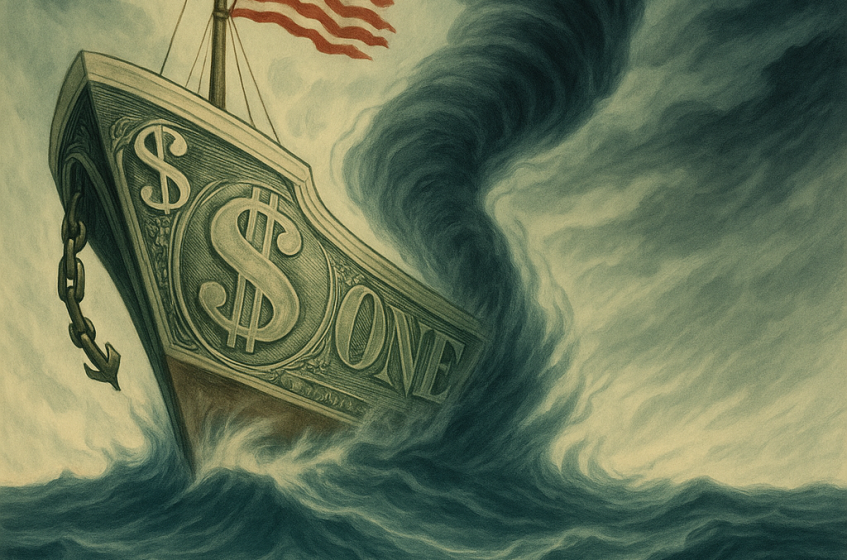
The U.S. Debt Storm and the Reshuffling of Global Finance
Dr Yifei Zhang
23 April 2025
In April 2025, global financial markets witnessed a textbook case of a credit crisis. The yield on the US 10-year treasury bonds shot up over 50 basis points within a single week, reaching a peak of 4.5%, marking the biggest weekly increase since the aftermath of the 9-11 incident in 2001. This phenomenon has not only subverted the traditional belief that the US treasury bonds are the world’s safest assets, but has also highlighted the deep-rooted vulnerabilities in the US dollar credit system.
The key to gasping the severity of this crisis involves understanding the fundamental financial concept of the “risk-free rate”. Long regarded as the anchor of global asset pricing, the US treasury yield has been used as a benchmark for calculating stock valuations, foreign exchange rates, and even residential mortgage rates. The core of the credit system hinges on the American government’s ability to repay its debts. Theoretically, the government can print money to meet its debt obligations, making a default improbable. However, if the market starts to question such a logic, the stability of the entire financial system is subject to challenge.
Apparently, the crisis has been triggered by technical factors. On 8 April 2025, the US Treasury Department’s auction of three-year treasury notes drew weak demand, receiving bids only 2.26 times the amount offered, registering a record low since 2023. However, an even deeper structural conflict lies in the fact that the basis trade strategy of hedge funds amplifies market fluctuations. Given the 50 times leverage on yield spreads between long-term and short-term government bonds under this strategy, if the yield fluctuates by more than 1%, positions exceeding US$600 billion would be forced to close, potentially leading to a chain stampede. During the recent mass exodus of traditional bond buyers, China has reduced its holdings of US bonds for two consecutive months and has augmented its gold reserves. Amid the weak-yen crisis, Japan has dumped US bonds to rescue its economy. Meanwhile, Saudi Arabia has begun settling oil payments in RMB through Hong Kong’s Cross-border Interbank Payment System (CIPS).
The fact that the above three major events coincided is no coincidence. As the world’s largest holder of US treasury bonds, China has been disposing of its holdings, thus weakening the demand for the dollar as the official reserve currency. Japan’s passive selling of American bonds reveals the weakness of US treasuries amid extreme foreign exchange volatility. Saudi Arabia’s attempt to settle trade transactions in local currency poses a direct challenge to the monopolistic status of the dollar in bulk commodity pricing. Once the greenback has been compromised as the “official reserve currency anchor”, a “stable foreign exchange rate anchor”, and a “bulk commodity pricing anchor”, markets will come to realize that the myth of “risk-free asset” is actually a collective compromise made by countries in response to America’s financial and military hegemony during the globalization era.
According to data from the US Department of Treasury, the federal government’s interest expenses for 2025 could amount to US$1.5 trillion, representing one-third of its fiscal revenue. If American bond yields continue to surge, the US may find itself in a debt abyss ― repaying old debts by borrowing anew, thereby triggering a sovereign credit crisis. The disintegration of this logic signifies an unprecedented threat to the US dollar-centric financial order worldwide in the aftermath of the Second World War.
In the traditional financial model, a stock market crash often redirects fund flows to government bonds, which are considered a safe haven. However, the market performance this month utterly upended this principle. Within merely a week, the US stock market lost US$8 trillion in value, while the US Dollar Index plunged below the 100 mark. Instead of prompting investors to seek refuge in US treasury bonds, the three markets―US stocks, bonds, and foreign exchanges―experienced simultaneous crashes. These market anomalies stem from the White House’s policy vacillations, compounded by geopolitical rivalry.
Trump’s tariff policy has become a catalyst for market volatility. His administration adjusted tariff rates on China three times within eight days, driving the rates up to 145%. Besides making it impossible for enterprises to formulate long-term production plans, policy uncertainty has also created chaos in supply chain arrangements within 90 days. Investors find themselves in a “liquidity black hole”, where assets including stocks, bonds, and foreign exchanges have all become high-risk targets, leaving cash as the only investment option. Although the White House has suspended some of the tariffs, the persistent 10% baseline rate and the 90-day pause are insufficient to alleviate the ongoing panic.
The impact of the self-undermining hegemonic US dollar is particularly far-reaching. America’s frequent weaponization of the financial system has compelled China and Russia to switch to local currency settlement, resulting in 83% of their energy trade being decoupled from the dollar-denominated system. Saudi Arabia has begun conducting oil trade transactions in RMB through Hong Kong’s financial infrastructure, directly challenging the dollar’s monopolistic status in bulk commodity pricing. There are market concerns that the US may resort to legal defaults to address its national debt crisis. This could involve forcing other countries to convert short-term American bonds into 50-year zero-coupon bonds, effectively shifting American bonds from a safe-haven instrument to a source of risk.
Beyond altering the market’s operational logic, the current crisis has reshaped public awareness of the nature of the financial system. The changes reflected in the three macroeconomic indicators below are instrumental in fostering people’s understanding of the new financial order.
Extent of the inverted US bond yield curve. An inverted yield curve, i.e. short-term bond yields higher than long-term bond yields, is a warning sign of an economic recession. Currently, the latest rate difference between 10-year American bonds and two-year treasuries has widened to -120 basis points, signifying the steepest inverted yield curve since 1981. Evidently, the market has grown wary of the US government’s financial sustainability. Once interest expenses consume two-thirds of fiscal revenue (estimated figure amounting to US$1.5 trillion in 2025), investors would demand higher risk premiums.
Share of US dollar in global reserves. Data of the International Monetary Fund shows that the share of US dollar as the world’s reserve currency has slid from 73% in 2001 to 52% in the first quarter of 2025. This drop coincides with rising allocations to RMB-denominated foreign-exchange reserves and gold holdings, reflecting a re-assessment of the dollar’s credit stability among central banks worldwide. Saudi Arabia’s use of RMB to settle oil trades via Hong Kong’s CIPS system exhibits a microcosmic sign of de-dollarization.
Share of RMB in cross-border payments. The use of RMB in international trade settlement has soared from 2.7% in 2022 to 9.3% in April 2025. As the world’s largest offshore RMB centre with deposits surpassing RMB1.2 trillion, Hong Kong serves as a vital window for observing the geoeconomic power shift.
The financial turmoil of 2015 is in essence a collective reflection on “American exceptionalism”. As the Trump administration attempts to maintain American hegemony through tariffs and sanctions, international markets react by dumping US bonds, stocks, and dollars. This crisis signals an irreversible trend away from sole reliance on the dollar, heralding a multipolar transformation of the global financial system.
Much like its role as an entrepot in the dollar-gold delink in 1971, Hong Kong now stands both as a witness to the fading old order and as a testing ground for the emerging new rules. The dynamic balance of the city’s Linked Exchange Rate System, the gradual internationalization of the RMB, and its position bridging Eastern and Western capital jointly provide individuals with a micro-perspective on the changing macroeconomic landscape.
While the investment bank traders in New York continue to debate over when the US Federal Reserve will cut rates, bankers in Hong Kong have already quietly increased their holdings of the Vietnamese Dong and the Malaysian Ringgit. The support for these currencies lies in Southeast Asian factories taking over parts of Chinese industrial chains. This may represent a new way forward for globalization: as the dollar hegemony progressively loses steam, nimble, small open economies have taken the initiative to carve out niches for their survival. It is within these niches that Hong Kong is proactively sowing the seeds for its future growth.







